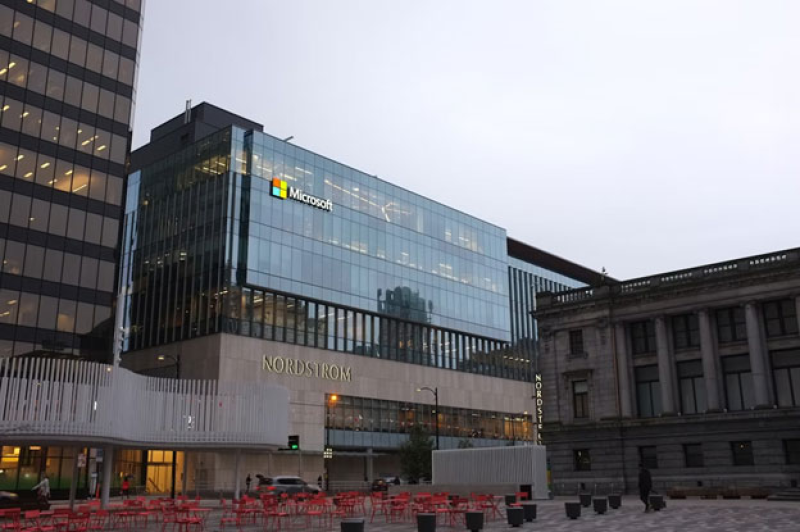- Trump considering military options on Greenland; Europe rejects |
- Fertiliser crunch threatens Kushtia’s onion boom despite high prices |
- Security Council Divided on United States' Venezuela Action |
- Over 1.53m voters register for postal balloting: Shafiqul Alam |
From Ads to AI: How Big Tech Dominates Our Digital World

Microsoft offices in Vancouver, Canada.
“The power of AI carries immense responsibilities. Today, that power sits in the hands of a few,” said UN Secretary-General António Guterres at the 2025 AI Action Summit, reflecting on a deepening reality as we inch closer to a world of complete digital domination. Today, seven of the world’s top ten most valuable companies are digital giants, focusing primarily on communication, digital manufacturing, artificial intelligence, and digital commerce, paving the way for a fully digitized life for all.
The top 10 companies include some of the biggest names in information technology and digital commerce:
NVIDIA: 4.002 trillion USD | Information Technology
Microsoft: 3.727 trillion USD | Information Technology
Apple: 3.172 trillion USD | Information Technology
Amazon: 2.359 trillion USD | Consumer Discretionary
Alphabet (Google): 2.161 trillion USD | Communication Services
Meta Platforms (Facebook): 1.828 trillion USD | Communication Services
Saudi Aramco: 1.627 trillion USD | Energy
Broadcom: 1.295 trillion USD | Information Technology
TSMC: 1.191 trillion USD | Information Technology
Berkshire Hathaway: 1.032 trillion USD | Consumer Discretionary
These companies actively reshape nearly every aspect of life, from showing you an ad for the brand-new phone you have been eyeing, to manufacturing the chip inside that very phone, and even delivering it to your doorstep. They are all connected and can be accessed with a single click.
Some of these firms have a near-digital monopoly on all aspects of the digital economy. Take Microsoft, for example:
E-Commerce and digital payment: Microsoft.com
Digital content and distribution: Xbox Game Pass, Windows Store, Microsoft Store
Social media: Teams, LinkedIn
Online search: Bing
Online advertising: Bing, Microsoft, LinkedIn Ads
Cloud services: Azure, Microsoft 365
AI models: Copilot
Your entire life can be run from one of these services, from finding your local market for groceries, buying a new laptop for work, storing your sensitive data, creating visualisations for that new project you’re working on, or even purchasing a video game. It’s all done by one company spread across a few platforms.
The vertical and horizontal consolidation of digital supply chains has made it nearly impossible for new companies to break into these markets. A lack of competition ultimately fuels higher prices, lower quality, and weaker privacy protections for consumers.
Consumers often unknowingly support and reinforce this system. If they rely on Google across all their devices, it creates a cycle lacking digital diversity, increasing the difficulty for smaller entities to innovate and break into the market.
By design, digital ecosystems keep users within a single company’s platforms, making it easy to move from service to service but at the hidden cost of freely giving up personal data.
Advertising plays a vital role in this campaign for dominance. 97.6 percent of Meta’s revenue and 75.6 percent of Google’s revenue comes just from ads. Just by being on their platforms, you’re generating billions of dollars without paying a single cent for use.
From 2020 to 2024, digital multinational enterprises (MNEs) accounted for one-third of all greenfield data centre projects—initiatives built entirely from the ground up. Logistic projects, in contrast, only accounted for 10 percent. This shows how massively the digital world is expanding, fuelled by investments in immersive online environments where users are increasingly spending money on non-physical assets, creating endless revenue streams out of thin air.
In China, the concentration of digital markets is even more extreme, given that certain American applications do not operate there. A handful of firms—Alibaba, Tencent, and ByteDance—control the population’s entire digital ecosystem. As the world’s second-most populous country, this is no small feat. WeChat alone is used by 95 percent of the population, centralising social media, messaging, payments, and e-commerce into one platform. This means competition effectively does not exist.
From 2017 to 2025, the combined sales share of the top five digital MNEs doubled from 21 percent to 48 percent, showing immense growth over eight years. This trend was also observed within asset concentration, where the top five digital firms doubled from 17 percent to 35 percent during the same period.
As digital markets surge, so does dominance in the AI value chain. Just two companies, Microsoft and Alphabet, control 78 percent of AI development from start to finish, largely through partnerships with startups like OpenAI and Anthropic. This allows them to virtually own every link in the chain—from data collection to model training, deployment, and application.
Generative AI requires massive capital, computing power, cloud services, AI chips, talent, and most importantly, data, which only the tech giants control. There is hardly any room for smaller firms to compete. This dynamic has serious market-limiting implications, as AI becomes necessary for digital expansion.
As UN Secretary-General António Guterres warned at the 79th General Assembly in 2024, “A handful of companies and even individuals have already amassed enormous power over the development of AI—with little accountability or oversight for the moment.”

